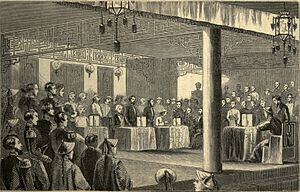- Treaty of Tientsin
-
Treaty of Tientsin 
Signing of the treaty between Britain and China Traditional Chinese 天津條約 Simplified Chinese 天津条约 Transcriptions Mandarin - Hanyu Pinyin Tiānjīn Tiáoyuē Several documents known as the "Treaty of Tien-tsin" were signed in Tianjin (Tientsin) in June 1858, ending the first part of the Second Opium War (1856–1860). The Second French Empire, United Kingdom, Russian Empire, and the United States were the parties involved. These treaties opened more Chinese ports (see Treaty of Nanking) to the foreigners, permitted foreign legations in the Chinese capital Beijing, allow Christian missionary activity, and legalized the import of opium.
They were ratified by the Emperor of China in the Convention of Peking in 1860, after the end of the war.
Contents
Dates
Terms
Major points
- Britain, France, Russia, and the United States would have the right to station legations in Beijing (Peking, a closed city at the time)
- Eleven more Chinese ports would be opened for foreign trade, including Newchwang, Tamsui (Taiwan), Hankou and Nanjing
- The right of foreign vessels including warships to navigate freely on the Yangtze River
- The right of foreigners to travel in the internal regions of China for the purpose of travel, trade or missionary activities
- China was to pay an indemnity to Britain and France in 2 million taels of silver respectively, and compensation to British merchants in 3 million taels of silver.
- Official letters and other documents exchanged between China and Britain are to be banned from referring to British Officials and Subjects of the Crown by the character "夷" (yí), meaning "barbarian".
Definitions
The Treaties of Tientsin uses several words that have somewhat ambiguous meanings. For example the words “settlement” and “concession” can often be confused. The term “settlement” refers to a parcel of land leased to a foreign power and is composed of both foreign and national peoples; locally elected foreigners govern them. The term “concession” refers to a long-term lease of land to a foreign power where the foreign nation has complete control of the land; it is governed by consular representation.[1]
American involvement
Following the pattern set by the great powers of Europe, the United States took on a protectionist stance, built up its navy, and tried to create a mercantile empire. The United States was one of the leading signing “treaty powers” in China, forcing open a total of 23 foreign concessions from the Chinese government. While it is often noted that the United States did not control any settlements in China, they shared British land grants and were actually invited to take land in Shanghai but refused because the land was thought to be disadvantageous.[2]
See also
- Unequal Treaties
- Imperialism in Asia
- 19th Century Protestant Missions in China
- William Bradford Reed
Notes
References
Additional sources
- William C Johnstone. "International Relations: The Status of Foreign Concessions and Settlements in the Treaty Port of China." American Political Science Review 31.5 (Oct. 1937): 942-8.
- Bloch, Kurt. "The Basic Conflict Over Foreign Concessions in China." Far Eastern Survey 8.10 (May 1939): 111-6.
- Pictures of the "Treaty Temple" in Tianjin and Texts of the treaties, Wason Library, Cornell University [1]
Categories:- Unequal treaties
- China–United Kingdom relations
- History of the United States (1849–1865)
- 1858 in China
- 1858 treaties
- 1860 treaties
- Treaties of the Second French Empire
- Treaties of the United States
- Treaties of the Russian Empire
- Treaties of the United Kingdom
- Treaties of the Qing Dynasty
Wikimedia Foundation. 2010.
